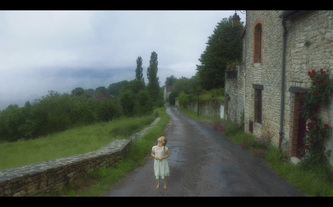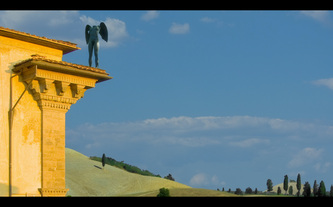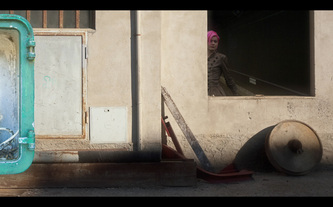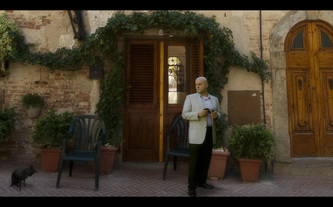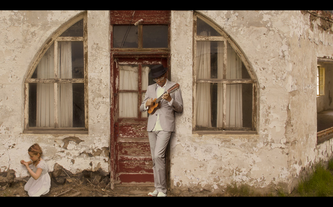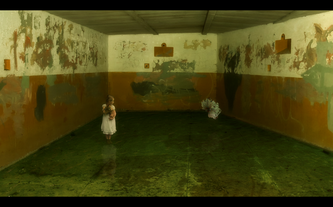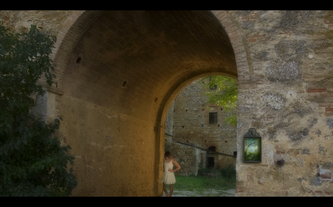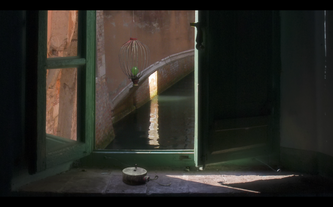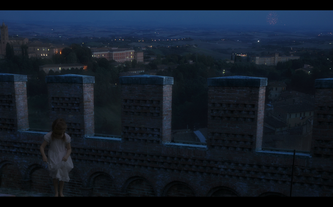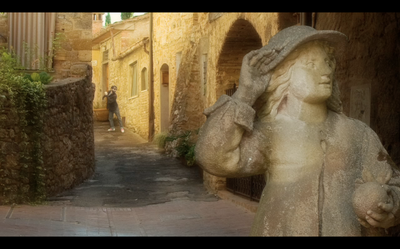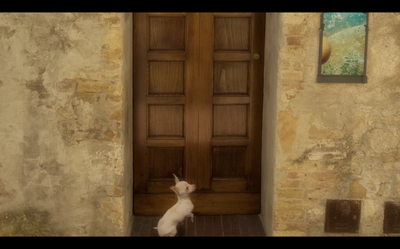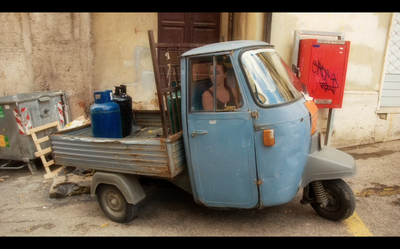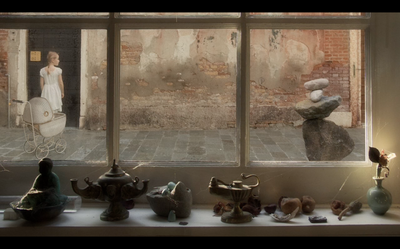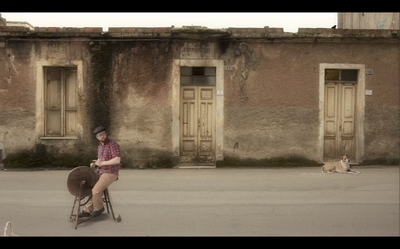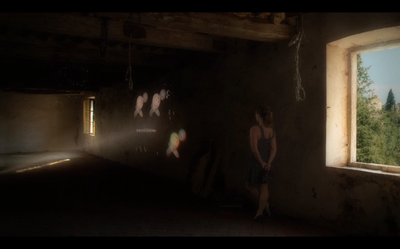Pulchrior in Luce, 2012
Running time: 87'
Four years in the making, Pulchrior in Luce (translated from Latin as More Beautiful in Light) is a feature-length experimental work comprised of twelve chapters (see chapters key*), occupying multiple genres. Inspired initially by 15th- and 16th-century painting as well as by Beaudrillard’s notion of hyperreality, the project was initiated in 2008 while working in Italy. I returned on three subsequent photographic expeditions to various locales in Western Europe, composing high-resolution digital photographs of buildings, architectural features, and landscape as well as recording ambient audio in situ.
In 2009, I began digitally collaging and animating these photographs to create a painterly, colorful and dreamlike virtual world. Video imagery of water, clouds, birds, animals, family, friends and acquaintances and photos of objects were subsequently matted and keyed into the collaged architectural spaces. The various elements of a shot, separated in virtual 3D space, may appear hyper-real to the viewer due to a lens-less and infinite depth-of-field combined with motion parallax.
Inhabiting the term ‘foregrounding’ are the aged and colorful surfaces, and architectural details, of buildings. Constellations of interior and exterior spaces become the subjects, with persons, objects and animals functioning as placeholders in potential, fragmented cinematic narratives that are occurring, or unfolding, in interstitial time, that quality of time where most of us live most of our lives… the long and ‘uneventful’ spaces between the high dramas, dramas whose distillation and explication remain dominant in narrative cinema and documentary.
There are excerpts of a number of my own previously realized artworks collaged into interior and exterior spaces throughout the piece providing a fragmentary document of that work in situations I can only dream of in virtual space without ever realizing in the physical world. In that sense I feel I am documenting desire, to some extent- something that is also present (though concealed) in much of traditional documentary. This is the domain of hyperreality as explicated by Italian author and semiotician Umberto Eco.
The influence of painting on this work is mostly formal in nature: sense of perspective and color palette. For example, the Fra Angelico painting of the saints Cosmas and Damian healing a deacon exemplifies a particular sense of perspective that was achieved photographically in my photographs of miniature rooms and furnishings (1:12 scale) employed in much of the final chapter in the film. The overall warm colorcast to many of his paintings (and some of those of de Chirico as well) was also something I wanted to achieve in my color grading of the work. In some of van Eyck’s paintings (hanging in the Groeningemuseum in Bruges) I found the same sense of containment I saw in Fra Angelico’s work, but with a certain intensity of color, which I found incredibly inspiring and tried to achieve through color grading and by employing 32-bit floating point color in every shot.
In viewing this work, one is invited to behold the ‘action’ or situations of the living characters in relation to the foregrounded interior/exterior collaged relationships, as well as objects, color and surface information, and then, through the arc of the piece, create or invent possible narratives, relationships, intentionalities and interstices. This is something that is required of all documentary viewing, it seems to me, even when the story is explicit and the focus is on the more traditional figure/ground arrangement.
-R. Campbell
*The twelve chapters:
Running time: 87'
Four years in the making, Pulchrior in Luce (translated from Latin as More Beautiful in Light) is a feature-length experimental work comprised of twelve chapters (see chapters key*), occupying multiple genres. Inspired initially by 15th- and 16th-century painting as well as by Beaudrillard’s notion of hyperreality, the project was initiated in 2008 while working in Italy. I returned on three subsequent photographic expeditions to various locales in Western Europe, composing high-resolution digital photographs of buildings, architectural features, and landscape as well as recording ambient audio in situ.
In 2009, I began digitally collaging and animating these photographs to create a painterly, colorful and dreamlike virtual world. Video imagery of water, clouds, birds, animals, family, friends and acquaintances and photos of objects were subsequently matted and keyed into the collaged architectural spaces. The various elements of a shot, separated in virtual 3D space, may appear hyper-real to the viewer due to a lens-less and infinite depth-of-field combined with motion parallax.
Inhabiting the term ‘foregrounding’ are the aged and colorful surfaces, and architectural details, of buildings. Constellations of interior and exterior spaces become the subjects, with persons, objects and animals functioning as placeholders in potential, fragmented cinematic narratives that are occurring, or unfolding, in interstitial time, that quality of time where most of us live most of our lives… the long and ‘uneventful’ spaces between the high dramas, dramas whose distillation and explication remain dominant in narrative cinema and documentary.
There are excerpts of a number of my own previously realized artworks collaged into interior and exterior spaces throughout the piece providing a fragmentary document of that work in situations I can only dream of in virtual space without ever realizing in the physical world. In that sense I feel I am documenting desire, to some extent- something that is also present (though concealed) in much of traditional documentary. This is the domain of hyperreality as explicated by Italian author and semiotician Umberto Eco.
The influence of painting on this work is mostly formal in nature: sense of perspective and color palette. For example, the Fra Angelico painting of the saints Cosmas and Damian healing a deacon exemplifies a particular sense of perspective that was achieved photographically in my photographs of miniature rooms and furnishings (1:12 scale) employed in much of the final chapter in the film. The overall warm colorcast to many of his paintings (and some of those of de Chirico as well) was also something I wanted to achieve in my color grading of the work. In some of van Eyck’s paintings (hanging in the Groeningemuseum in Bruges) I found the same sense of containment I saw in Fra Angelico’s work, but with a certain intensity of color, which I found incredibly inspiring and tried to achieve through color grading and by employing 32-bit floating point color in every shot.
In viewing this work, one is invited to behold the ‘action’ or situations of the living characters in relation to the foregrounded interior/exterior collaged relationships, as well as objects, color and surface information, and then, through the arc of the piece, create or invent possible narratives, relationships, intentionalities and interstices. This is something that is required of all documentary viewing, it seems to me, even when the story is explicit and the focus is on the more traditional figure/ground arrangement.
-R. Campbell
*The twelve chapters:
- nunc hinc, nunc illinc
- edifici
- sacralità
- complicatio/explicatio
- immaginazione senza fili
- condizione dell'ambiente
- oniricità
- haecceitas
- mise-en-abîme
- chronos
- kairos
- notte
